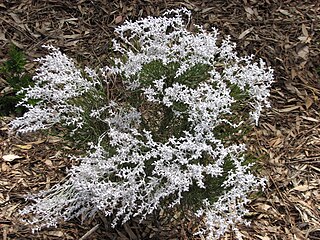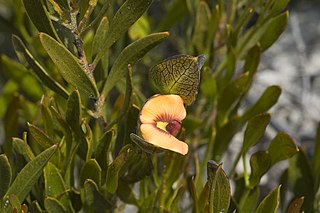
Conospermum stoechadis, commonly known as common smokebush, is a species of flowering plant in the family Proteaceae and is endemic to the south-west of Western Australia. It is an erect, compact shrub with thread-like leaves and spikes of woolly white, tube-shaped flowers.

Eremophila racemosa, also known as showy eremophila, is a flowering plant in the figwort family Scrophulariaceae, and is endemic to Western Australia. It is an erect shrub with glabrous leaves, small, green sepals and flowers that have many colour variations often changing as they age.

Grevillea integrifolia, commonly known as entire-leaved grevillea, is a species of flowering plant in the family Proteaceae and is endemic to the south-west of Western Australia. It is an erect shrub with egg-shaped leaves, the narrower end towards the base, and cylindrical clusters of white to creamy-white flowers.

Darwinia purpurea, commonly known as the rose darwinia, is a species of flowering plant in the family Myrtaceae and is endemic to the southwest of Western Australia. It is a spreading shrub with linear leaves and dense heads of red or yellow flowers surrounded by many overlapping involucral bracts.

Conospermum huegelii, commonly known as the slender smokebush, is a species of flowering plant endemic to the south-west of Western Australia. It is a low, clumped shrub with thread-like to narrowly cylindrical leaves, and spikes of pale blue to cream-coloured, tube-shaped flowers and hairy nuts.

Jacksonia lehmannii is a is a species of flowering plant in the family Fabaceae and is endemic to the south-west of Western Australia. It is an erect to prostrate or spreading, spindly shrub with greyish-green branches, sharply-pointed side branches, its leaves reduced to scales leaves, yellowish-orange flowers with orange-red markings, and woody, hairy pods.

Daviesia alternifolia is a species of flowering plant in the family Fabaceae and is endemic to the south-west of Western Australia. It is a dense, spreading shrub with scattered, egg-shaped phyllodes with the narrower end towards the base, and orange and red flowers with a greenish-yellow centre.

Daviesia oppositifolia, commonly known as rattle-pea, is a species of flowering plant in the family Fabaceae and is endemic to the south-west of Western Australia. It is an erect shrub with many stems, egg-shaped phyllodes with the narrower end towards the base, and yellow flowers with maroon markings.

Jacksonia alata is a species of flowering plant in the family Fabaceae and is endemic to the south-west of Western Australia. It is a tufted, semi-prostrate to erect shrub with flattened branches, sharply-pointed side branches or phylloclades, leaves reduced to narrowly lance-shaped scales, yellow-orange flowers with a red "eye", and woody, densely hairy pods.

Jacksonia angulata is a species of flowering plant in the family Fabaceae and is endemic to the south-west of Western Australia. It is a tufted, spreading to prostrate shrub often with zig-zagged branches, sharply-pointed side branches or phylloclades, leaves reduced to broadly egg-shaped scales, yellow-orange to orange flowers with a red "eye", and woody, densely hairy pods.

Jacksonia arenicola is a species of flowering plant in the family Fabaceae and is endemic to the south-west of Western Australia. It is an erect, broom-like shrub with densely hairy, sharply-pointed phylloclades, yellow-orange flowers with red markings, and woody pods that are hairy at first, later glabrous.

Jacksonia condensata is a species of flowering plant in the family Fabaceae and is endemic to the south west of Western Australia. It is a slender, ascending to erect shrub with sharply-pointed phylloclades, the leaves reduced to scales, yellow to yellow-orange flowers, and woody, hairy pods.

Jacksonia debilis is a species of flowering plant in the family Fabaceae and is endemic to the south west of Western Australia. It is a spreading to prostrate shrub with curved phylloclades, yellow-orange flowers with red markings, and woody, hairy pods.

Jacksonia dilatata is a species of flowering plant in the family Fabaceae and is endemic to the northern Australia. It is usually an erect shrub or small tree with narrowly egg-shaped phylloclades, the leaves reduced scales, and yellow flowers in clusters of up to 20 at the ends of the phylloclades.
Jacksonia epiphyllum is a species of flowering plant in the family Fabaceae and is endemic to the south of Western Australia. It is an erect or straggling shrub, the end branches egg-shaped or elliptic phylloclades, the leaves reduced to scale leaves, the flowers yellow-orange with red markings, and woody, densely-hairy pods.
Jacksonia eremodendron is a species of flowering plant in the family Fabaceae and is endemic to the south-west of Western Australia. It is a straggling shrub to small tree, the end branches egg-shaped, elliptic or oblong phylloclades with sharply-pointed teeth on the edges, the flowers yellow-orange with red markings and attached to teeth on phylloclades, and woody, densely-hairy pods.

Jacksonia forrestii, commonly known as broom bush, is a species of flowering plant in the family Fabaceae and is endemic to the north-west of Australia. It is an erect, slender, weeping shrub or tree with sharply pointed phylloclades, yellow to yellow-orange flowers without markings, and woody, hairy pods.

Jacksonia grevilleoides is a species of flowering plant in the family Fabaceae and is endemic to the south west of Western Australia. It is a prostrate or erect shrub with variably-shaped phylloclades, yellow-orange flowers and woody, densely hairy pods.

Jacksonia humilis is a species of flowering plant in the family Fabaceae and is endemic to the south of Western Australia. It is a spreading to prostrate shrub with dull green branches, sharply-pointed phylloclades, yellow-orange flowers with red markings, and membranous, densely-hairy pods.
Jacksonia jackson is a species of flowering plant in the family Fabaceae and is endemic to inland Western Australia. It is an erect, spindly, spreading shrub with dull green branches, the end branches sharply-pointed phylloclades, leaves reduced to egg-shaped scales, yellow-orange flowers with red markings, and woody, densely hairy pods.


















